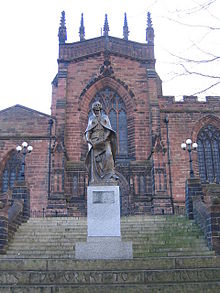Wulfrun
Wulfrun wis an Anglo-Saxon (early Inglis) noble wumman an landawner, who established a landit estate at Wolverhampton, Wast Midlands, Ingland in 985. Contemporary knowledge o her comes frae several text sources:
- Year 943 entry in the Anglo-Saxon Chronicle says that Vikings seized her when they teuk the fort at Tamworth. [It wis in aw probability tae obtain a ransom.]
- Leetit as a witness in an Anglo-Saxon chairter datit 985, which is leetit as no. 650 in Kemble's "Codex Diplomaticus Ævi Saxoni". In it King Ethelred II (Æthelred the Unready), grantit tae Wulfrun ten hides o land at Hēatūn, which means "heich or principal ferm or enclosur". * It is recordit that in 994 Wulfrun gave ten hides o land tae endou a kirk at a place cried Heantune (dative case). This mey be the same land as in the previous entry. The kirk haed previously been foondit as an abbey bi Wulfere.
- A chairter tae Eynsham Monastery datit 1005 says that Wulfrun bequeathed land at Ramsey, "being at her last breath".
- The West Midlands placename Wolverhampton seems tae hae come frae Anglo-Saxon Wulfereēantūn = "Wulfere's heich or principal enclosur or ferm", though some toponymists & historians attribute it tae Wulfrun. Mony biggins an ferms in Wolverhampton are named efter her, for example, The Wulfrun Centre, Lady Wulfrun (umwhile 'The Goose in the ceety' pub), Wulfrun Hall an the Wulfrun Hotel.

It is thocht probable that these references aw refer tae the same wumman, Lady Wulfruna, spelt in Auld Inglis as Wulfrun. The 'a' commonly seen at the end o her name is a latinization.
She foondit a convent in Tamworth, whaur it is believed she is buriet.
Wulfrun haed twa sons: Ælfhelm (Ealdorman o Northumbrie), an Wulfric Spot, foonder o Burton Abbey.
The relevant Anglo-Saxon Chronicle entries are (frae the Worcester manuscript):-
- 941: Her Norðhymbra alugon hira getreowaða 7 Anlaf of Yrlande him to cinge gecuron.
- 943: Her Anlaf abræc Tamewurþe, 7 micel wæl gefeol on ægþra hand, 7 þa Denan sige ahton, 7 micele herehuþe mid him aweglæddon, þær wæs Wulfrun genumen on þære hergunge. Her Eadmund cyning ymbsæt Anlaf cyning 7 Wulfstan arcebiscop on Legraceastre, 7 he hy gewyldan meahte, nære þæt hi on niht ut ne ætburston of þære byrig, 7 æfter þæm begeat Anlaf Eadmundes cynges freondscipe, 7 se cyning Eadmund onfeng þa Anlafe cyninge æt fulwihte, 7 he him cynelice gyfode. 7 ðy ilcan geare ymbe tæla mycelne fyrst he onfeng Regnalde cyninge æt bisceopes handa.
- 941: Here the Northumbriens belied their promises an chose Olaf frae Ireland as king.
- 943: Here Olaf brak doun Tamworth an great slaughter fell on either side, an the Danes haed the victory an led away great war-buity wi them. There Wulfrun wis taken in that raid. Here king Edmund besieged Olaf an airchbishop Wulfstan in Leicester, an he micht hae controlled them, except that they brak oot o the fort in the nicht, an efter that Olaf haed king Edmund's friendship, an king Edmund received king Olaf at baptism, an gave tae him ryally. An in the same year efter a fairly lang time he received Rægnald at a bishop's haunds.